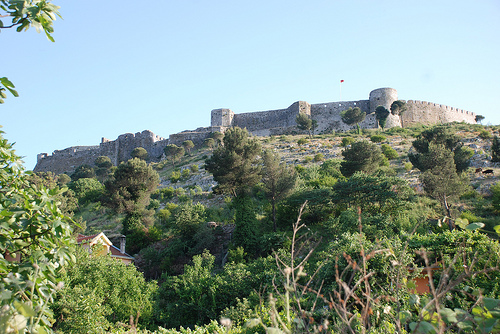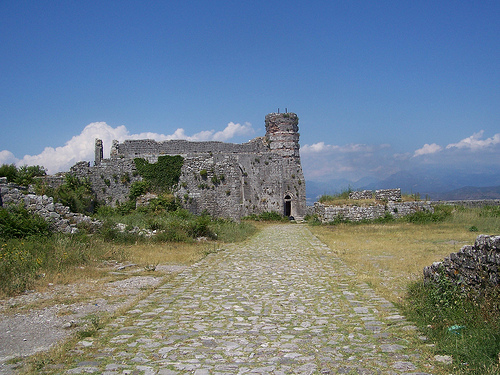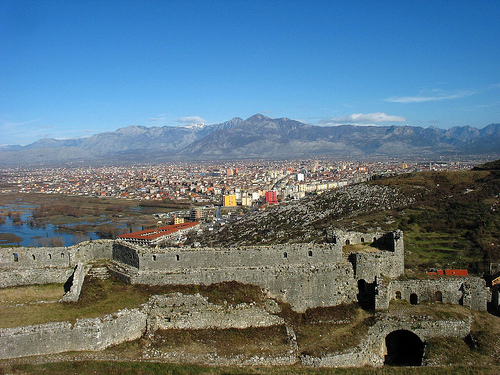


RozafaCastle Museum
Open: 8:00 to 19:00
Entry fee: 150 LEK
Rozafa Castle, also known as Shkodër
Castle, is a historic fortress located in northwestern Albania, just
south of the city of Shkodër. Perched on a rocky hill rising 130
meters (430 feet) above sea level, it overlooks the confluence of
the Buna and Drin rivers, with stunning views extending to Lake
Shkodra (also known as Lake Scutari). This strategic position has
made it a key defensive site for millennia, controlling vital trade
routes and waterways in the region. Today, it stands as one of
Albania's most iconic landmarks, blending ancient ruins with layers
of historical modifications, and serves as a symbol of Albanian
resilience and cultural heritage.
The history of Rozafa Castle spans from prehistoric times to the
modern era, reflecting the turbulent past of the Balkans. Archaeological
evidence indicates human settlement on the hill dating back to the Early
Bronze Age, with the earliest fortifications constructed by the
Illyrians in the 4th or early 3rd century BCE. This initial citadel
served as the core of the Illyrian city of Scodra (or Skodra), the
capital of tribes like the Labeates and Ardiaei under rulers such as
King Gentius. During this period, the city flourished as a political and
economic center.
In 168 BCE, during the Third Illyrian War, Roman
forces under Lucius Anicius Gallus besieged and captured Scodra, marking
the end of Illyrian independence. The Romans incorporated the site into
their empire, followed by Byzantine control. Over the subsequent
centuries, the castle changed hands among various powers, including the
Duklja principality, the First Bulgarian Empire, the Serbian Grand
Principality, the Kingdom of Serbia, the Serbian Empire, the Lordship of
Zeta, and the Principality of Zaharia.
By the late 14th century,
Venice took control, fortifying the castle extensively in the 15th
century as a bulwark against Ottoman expansion along the eastern
Adriatic coast. One of the most famous events was the Siege of Shkodër
in 1478–1479 during the First Ottoman-Venetian War, where Ottoman forces
under Sultan Mehmed II besieged the castle. Despite fierce resistance,
the Venetians ceded it to the Ottomans in a peace agreement in April
1479. The Ottomans held the castle for over four centuries, using it as
an administrative and military base until the Siege of Scutari in
1912–1913, when Montenegrin forces, part of the Balkan League, captured
it after a grueling six-month siege.
In the 20th century, the castle
saw involvement in both World Wars and became a symbol during Albania's
National Awakening and path to independence in 1912. Archaeological
excavations since 2011, led by teams including Polish archaeologist
Piotr Dyczek, have revealed Hellenistic pottery, walls from the 3rd to
1st century BCE, amphorae fragments, and evidence of a larger Illyrian
lower town along the riverbanks, confirming the site's extensive ancient
urban footprint.
The confluence of the rivers Buna
and Drini

Rozafa Castle's architecture is a testament to its multifaceted
history, with an irregular layout that conforms to the natural contours
of the rocky hill, creating a naturally fortified structure. The castle
spans approximately 9 hectares and is divided into three baileys
(courtyards), connected by pathways and gates. The walls, primarily
built from local limestone and brick, feature Cyclopean-style masonry
from the Illyrian era, with later additions including Venetian
reinforcements and Ottoman modifications.
Notable structures
include:
Entrance Gate and Pathways: Visitors enter via a cobblestone
path leading to the main gate, a fortified Venetian-era portal with
defensive towers.
Venetian Tower: A prominent round tower offering
panoramic views, used historically for surveillance.
Church-Mosque
(St. Stephen's Cathedral/Fatih Sultan Mehmet Mosque): Originally a
13th-century Venetian Catholic church in the second bailey, it was
converted into a mosque after the 1479 Ottoman conquest, featuring ruins
that blend Gothic and Islamic elements.
Cisterns and Arsenal:
Underground water reservoirs and storage facilities designed to
withstand sieges, including a Venetian cistern with inscriptions.
Ossuary and Ottoman Remains: An ossuary for bones, an Ottoman road, and
a 14th-15th century cemetery near the Lead Mosque (though the mosque
itself is outside the main walls).
Illyrian Gateway: Ancient entrance
with stalactites and milkweed sap, tied to local folklore.
The
castle's design emphasizes defense, with high walls, battlements, and
strategic positioning. Recent preservation efforts have focused on
stabilizing these features through local and international
collaborations.

Central to the castle's cultural significance is the poignant legend
of Rozafa, a tale of sacrifice rooted in Albanian folklore and
documented as early as 1505 by historian Marin Barleti. According to
the story, three brothers (sometimes identified as members of the
Mrnjavčević family in variants) attempted to build the castle, but
the walls mysteriously collapsed each night. A wise old man advised
them that the foundations required a human sacrifice: the wife who
brought them food the next day must be immured alive in the walls.
The brothers swore secrecy under the Albanian code of besa, but the
two elder ones warned their wives, leaving the youngest's wife,
Rozafa, unaware.
When Rozafa arrived with the meal, she learned
her fate but selflessly agreed, on the condition that openings be
left in the wall for her right eye (to watch her infant son), right
hand (to caress him), right foot (to rock his cradle), and right
breast (to nurse him). After her immurement, the walls stood firm.
The legend symbolizes themes of maternal love, loyalty, and
sacrifice, with locals believing that the "weeping wall"—where
milkweed sap and limestone stalactites form—represents Rozafa's
enduring milk. Women traditionally scrape these deposits to create
remedies for lactation and to instill patriotic virtues in children.
This motif echoes ancient earth mother goddess worship in Albanian
beliefs and appears in similar Balkan tales, such as the Serbian
epic The Building of Skadar.
From the castle's ramparts, visitors are treated to breathtaking vistas of the turquoise rivers snaking through fertile valleys, the expansive Lake Shkodra, distant mountains, and the city of Shkodër below. These panoramic views highlight the site's strategic importance and natural beauty, making it a photographer's paradise.
Today, Rozafa Castle is owned by the Albanian state and designated as part of an archaeological park, open to the public year-round with a small entrance fee that supports preservation. It attracts around 50,000 visitors annually (as of 2017 data, with numbers likely growing), offering a museum within the walls that houses artifacts, including a life-sized sculpture of Rozafa by artist Skender Kraja. As of 2025, ongoing restoration projects, in partnership with international organizations, aim to conserve the site amid cultural events like summer concerts, folk festivals, and dance performances that celebrate Albanian heritage. Access is easy from Shkodër's center by car, taxi, or a short hike, though comfortable shoes are recommended due to uneven terrain. The best times to visit are spring or autumn for milder weather, and it's often combined with nearby attractions like the Mesi Bridge or Lake Shkodra excursions. Dining options in Shkodër feature traditional Albanian cuisine, enhancing the cultural immersion.